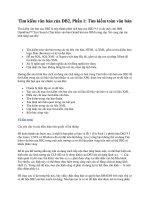Bài giảng Client/Server - Chương 14: Tìm kiếm toàn văn pptx
Bạn đang xem bản rút gọn của tài liệu. Xem và tải ngay bản đầy đủ của tài liệu tại đây (551.97 KB, 32 trang )
1
Bài 14: Tìm kiếm toàn văn
1. Lưu trữ dữ liệu toàn văn trong CSDL và khái niệm chung về (Full
text search – FTS)
2. Quản trị FTS
3. Cấu hình chỉ mục và tạo chỉ mục cho FT-Index bằng giao diện của
MStdio
4. Cấu hình chỉ mục và tạo chỉ mục cho FT-Index bằng T-SQL
5. Tạo chỉ mục FT-Index cho các trường
varchar(max),nvarchar(max), image
6. Thực hiện các câu truy vấn TFS
1. CONTAINS
2. CONTAINSTABLE
3. FREETEXT
2
Lưu trữ dữ liệu tòan văn trong các trường
Bảng Production.Document có chứa dữ liệu toàn văn trong trường Document
Column Data type Nullability Description
DocumentID int Not null
Primary key for Document rows.
Title nvarchar(50) Not null
Title of the document.
FileName nvarchar(400) Not null
Directory path and file name of
the document.
FileExtension nvarchar(8) Not null
File extension indicating the
document type. For
example, .doc or .txt.
Revision nvarchar(5) Not null
Revision number of the
document.
Document varbinary(max) Null
Complete document file.
3
Khái niệm chung về FTS
•
Full-text index: lưu trữ thông tin về các từ có nghĩa và vị trí của nó. Thông
tin này được sử dụng để thực hiện tìm kiếm nhanh ra các bản ghi chứa từ
này.
•
Full-text catalog: là nơi để lưu trữ các full-text indexes. Các Full-text
catalogs phải được lưu trữ trên local hard drive không thể lưu trên
removable drives, floppy disks, or network drives.
•
Word breaker: đưa vào một văn bản + ngôn ngữ, Word breaker sẽ sử dụng
các lexical rules để phân tích văn bản ra thành các từ có nghĩa.
•
Stemmer: đưa vào một ngôn ngữ + một từ, Stemmer sẽ tạo ra các dạng
khác nhau của từ đó (số ít, số nhiều, …)
•
Noise words: là các từ không có ý nghĩa trong tìm kiếm. For example, for
the English words such as "a", "and", "is", and "the" are considered noise
words. Các từ này sẽ bị bỏ qua trong quá trình tạo FT-Index. Danh sách
các Noise words của các ngôn ngữ nằm trong thư mục C:\Program
Files\Microsoft SQL Server\MSSQL.1\MSSQL\FTData (noiseENG.txt;
noiseRUS.txt; noiseFRA.txt)
4
Quản trị FTS
•
Creating full-text indexes and full-text catalogs.
•
Altering existing full-text indexes and catalogs.
•
Dropping existing full-text indexes and catalogs.
•
Scheduling and maintaining index population.
5
Cách tạo FTS bằng MStdio
•
How to enable a database for full-text indexing
•
How to enable a table for full-text indexing
•
How to remove a full-text index from a table
•
How to remove a full-text catalog from a database
•
How to remove all full-text catalogs from a database
6
How to enable a database for full-text indexing
7
How to enable a table for full-text indexing
1. Expand the server group, expand Databases, expand
User Databases, and expand the database that contains
the table you want to enable for full-text indexing.
2. Right-click the table that you want to enable for full-
text indexing.
3. Select Full-Text index, and then click Define Full-
Text index…
8
Truy vấn dựa trên FT Index
USE AdventureWorks;
GO
SELECT DocumentID, DocumentSummary, Document
FROM Production.Document
WHERE CONTAINS(Document, 'Reflector NEAR
Bracket');
GO
9
Remove a full text index
•
To remove a full-text index from a table
–
In Microsoft SQL Server Management Studio, right-click the table that has
the full-text index that you want to delete.
–
Select Delete Full-Text index from the context menu.
–
Click OK when prompted to confirm that you want to delete the full-text
index.
•
To remove a full-text catalog from a database
–
In Microsoft SQL Server Management Studio, expand the server
group, expand Databases, and expand the database that contains
the full-text catalog you want to remove.
–
Expand Storage, and expand Full Text Catalogs.
–
Right-click the full-text catalog that you want to remove and
select Delete.
–
Click OK in the Delete Objects dialog box.
10
Remove all full-text catalogs from a database
•
In Microsoft SQL Server Management Studio, expand the
server group, expand Databases, and expand the database
that contains the full-text catalogs you want to remove.
•
Expand Storage.
•
Right-click Full-Text Catalogs and select Delete all.
•
Click OK in the Delete Objects dialog box.
11
Cấu hình chỉ mục và tạo chỉ mục cho FTS bằng T-SQL
Thiết lập FTS cho CSDL
sp_fulltext_database [@action =] 'enable|disable'
–
USE AdventureWorks;
–
GO
–
EXEC sp_fulltext_database 'enable';
12
Cấu hình chỉ mục và tạo chỉ mục cho FTS bằng T-SQL
Tạo danh mục cho FTS trong CSDL
CREATE FULLTEXT CATALOG catalog_name
[ON FILEGROUP filegroup ]
[IN PATH 'rootpath']
[WITH <catalog_option>]
[AS DEFAULT]
[AUTHORIZATION owner_name ]
<catalog_option>::= ACCENT_SENSITIVITY = {ON|OFF}
IN PATH – chỉ định thự mục của Catalog (mặc định là C:\Program
Files\Microsoft SQL Server\MSSQL.1\MSSQL\FTData)
AS DEFAULT – chỉ định đây là Catalog mặc định cho
các FT-Indexes.
13
Cấu hình chỉ mục và tạo chỉ mục cho FTS bằng T-SQL
Tạo danh mục cho FTS trong CSDL
USE AdventureWorks;
GO
CREATE FULLTEXT CATALOG ftCatalog AS DEFAULT;
GO
CREATE FULLTEXT INDEX ON
HumanResources.JobCandidate(Resume) KEY INDEX
ui_ukJobCand;
GO
14
Cấu hình chỉ mục và tạo chỉ mục cho FTS bằng T-SQL
Sửa đổi danh mục cho FTS trong CSDL
ALTER FULLTEXT CATALOG catalog_name
{ REBUILD [WITH ACCENT_SENSITIVITY = {ON|OFF} ]
| REORGANIZE | AS DEFAULT }
REORGANIZE – tối ưu cấu trúc của Catalog
Change to accent insensitive
USE AdventureWorks;
GO
ALTER FULLTEXT CATALOG ftCatalog
REBUILD WITH ACCENT_SENSITIVITY=OFF;
GO
Check Accentsensitivity
SELECT FULLTEXTCATALOGPROPERTY('ftCatalog', 'accentsensitivity');
GO
Returned 0, which means the catalog is not accent sensitive.
15
Cấu hình chỉ mục và tạo chỉ mục cho FTS bằng T-SQL
Xóa danh mục cho FTS trong CSDL
•
DROP FULLTEXT CATALOG catalog_name
16
Cấu hình chỉ mục và tạo chỉ mục cho FTS bằng T-SQL
Tạo chỉ mục
CREATE FULLTEXT INDEX ON table_name
[(column_name [TYPE COLUMN type_column_name]
[LANGUAGE language_term] [, n])]
KEY INDEX index_name
[ON fulltext_catalog_name]
TYPE COLUMN type_column_name – chỉ cần đối với các cột kiểu
varchar(max),nvarchar(max), image
KEY INDEX index_name – tên của một chỉ mục unique đã có
17
Cấu hình chỉ mục và tạo chỉ mục cho FTS bằng T-SQL
Tạo chỉ mục
USE AdventureWorks;
GO
CREATE UNIQUE INDEX ui_ukJobCand ON
HumanResources.JobCandidate(JobCandidateID);
CREATE FULLTEXT CATALOG ft AS DEFAULT;
CREATE FULLTEXT INDEX ON
HumanResources.JobCandidate(Resume) KEY INDEX
ui_ukJobCand;
GO – Xem thông tin về chỉ mục của một bảng
exec sp_helpindex 'HumanResources.JobCandidate'
18
Cấu hình chỉ mục và tạo chỉ mục cho FTS bằng T-SQL
•
Sửa đổi chỉ mục
ALTER FULLTEXT INDEX ON table_name
{ ENABLE | DISABLE
|ADD(column_name[TYPE COLUMN type_column_name]
[LANGUAGE language_term] [, n] )
[WITH NO POPULATION]
| DROP (column_name [, n] )
[WITH NO POPULATION]
| START {FULL|INCREMENTAL|UPDATE} POPULATION
| STOP POPULATION
}
19
Cấu hình chỉ mục và tạo chỉ mục cho FTS bằng T-SQL
Sửa đổi chỉ mục FT-Index
USE AdventureWorks;
GO
ALTER FULLTEXT INDEX ON
HumanResources.JobCandidate ENABLE;
GO
20
Cấu hình chỉ mục và tạo chỉ mục cho FTS bằng T-SQL
Xóa chỉ mục FT-Index
DROP FULLTEXT INDEX ON tabl e_name
21
Tạo FT-Index cho các trường nhị phân
USE AdventureWorks;GO
CREATE FULLTEXT CATALOG ftCatalog AS DEFAULT;GO
EXEC sp_help_fulltext_tables Danh sach cac bang da co FT-Index
GO
EXEC sp_helpindex 'Production.Document'
CREATE FULLTEXT INDEX ON Production.Document
(Document TYPE COLUMN FileExtension) KEY INDEX PK_Document_DocumentID;
GO
/*
CREATE FULLTEXT INDEX ON Production.Document(Document)
KEY INDEX PK_Document_DocumentID;
Co loi
DROP FULLTEXT INDEX ON Production.Document
*/GO
Test FT-Index
USE AdventureWorks; GO
SELECT DocumentID, DocumentSummary, Document
FROM Production.Document
WHERE CONTAINS(Document, 'Reflector NEAR Bracket');
22
Cú phát tìm kiếm Full text
Sau khi đã có Full Text Index chúng ta sử dụng các từ khóa
sau đây để thực hiện việc tìm kiếm:
CONTAINS; CONTAINSTABLE
FREETEXT; FREETEXTTABLE
23
CONTAINS
CONTAINS (
{ column_name | (column_list) | * }
, '< contains_search_condition >'
[ , LANGUAGE language_term ]
)
< contains_search_condition > ::=
{ < simple_term >
| < prefix_term >
| < generation_term >
| < proximity_term >
| < weighted_term >
}
| { ( < contains_search_condition > )
[ { < AND > | < AND NOT > | < OR > } ]
< contains_search_condition > [ n ]
}
24
Các ví dụ về FTS theo Contains
Using CONTAINS with <simple_term>
Using CONTAINS and phrase in <simple_term>
Using CONTAINS with <prefix_term>
Using CONTAINS and OR with <prefix_term>
Using CONTAINS with <proximity_term>
Using CONTAINS with <generation_term>
Using CONTAINS with <weighted_term>
Using CONTAINS with variables
(Xem trong file: Lecture10-contains.doc)
25
CONTAINSTABLE
CONTAINSTABLE ( table , { column_name | (column_list ) | * } ,
' < contains_search_condition > '
[ , LANGUAGE language_term]
[ ,top_n_by_rank ]
)
< contains_search_condition > ::=
{ < simple_term >
| < prefix_term >
| < generation_term >
| < proximity_term >
| < weighted_term >
}
| { ( < contains_search_condition > )
{ { AND | & } | { AND NOT | &! } | { OR | | } }
< contains_search_condition > [ n ]
}









